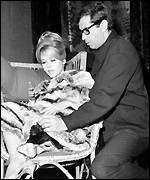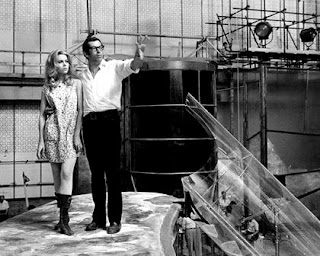
Jane Fonda’s France is not normal. The American actor first came here at nineteen, staying at a villa her father, Henry, had rented near Villefrance in the south. There she met the Agnellis, Jacqueline Ribes, Princess Monica Gircona, and brother Bino, Count and Countess Volpi, JFK and Jackie, Onasis, Picasso, Cocteau, Hemingway and Chaplin. This year Jane Fonda is 70!
She went swimming with a naked Garbo, but kept her costume on. She took an apartment in Paris, on the avenue d’ Iêna, went to art school but – unlike Robert Redford – never got to paint. At a dinner-dance at Maxim’s she saw a man with exotic eyes and “an erotic aura” but nothing happened. Instead she had an affair with a playboy who took nude photographs of her; Henry Fonda ordered her home.
By the time she returned to France in 1963 Fonda had a fledging movie career and was taken under the wing of the French actors, Simone Signoret and Yves Montand. They were, Fonda says, “engagé” – politically active.
This time, shortly after JFK’s murder, and an impotent courtship (which tells us something), she began a relationship with the man with the exotic eyes. They found a house together in the Marais, she learnt to cook and helped arrange “threesomes” for her partner – and husband to be – Roger Vadim Plemiannikov.
“I’ll tell you what I did enjoy,” Fonda writes about these frolics, “the mornings after, when Vadim wa gone and the woman and I would linger over our coffee and talk. For me it was a way to bring some humanity to the relationship, an antidote to objectification. I would ask her about herself, trying to understand her history and why she had agreed to share our bed…”
Many things are interesting about the Fonda-Vadim relationship: not least that it was a “big” and symbolic one, open, glamourous and “free”. French most of all, in most non-French eyes. Vadim “abhorred jealousy”, but had a gambling addiction – on anything, even racing Scalextrix model cars. He did not, surprisingly, rate fidelity high on the “to do” list. But then Vadim was haunted by his teenage experiences of occupied France in the Second World War – much later in life he wrote a gothic novel of sex and death, set in that era.
“At 16,” he writes,
“I had established a rule for myself: I was going to take the best from life: The sea, nature, sports, Ferraris, friends and pals, art, nights of intoxication, the beauty of women, insolence and nose-thumbing at society. I kept my politics…but refused commitment of any form. I believed in man the individual, but had lost my faith in mankind at large. ”
Vadim sounds a little like many men of this generation. At least his friends were interesting: Gide, Dali, Piaf, Cocteau; and Vadim shared a mistress with Hemingway for a while. And read aloud to Collette in her apartment.

When the pair first got together they were given somewhere to live in the Hôtel des Ambassadeurs by Commander Paul-Louis Weiller. It was on the rue Vieille-du-Temple, a hundred yards from where I am now staying. It was huge space, filled with artists, friends and young models; a room was always kept for Chaplin but the Vadims never saw him. Roland Petit, who had directed Leslie Caron at the ballet, lived there as well.
History’s hauntings happen in the strangest places. Drawn to the Fonda story as an example of chosen exile, I am suddenly considering the nature of modern romance too, incredibly close to the Parisian base of Fonda-Vadim. Fonda was exiled not just from America, but from the American way, and yet choose to be with a playboy Frenchman whose autobiography was entitled “Memoirs of the Devil.” (It’s a pretty self-serving text, full of stories about the week Ursula Andress came to sleep (celibately) with Vadim and his first wife, Brigitte Bardot.)
And now walking in the same street, and away from my own, the Rue Des Archives, with the giant repository of national history, I am thinking about why relationships work or fail.
Fonda hints that she was with Vadim because he had been (and would be) with beautiful and famous women: he validated her. For all the coquettish sexuality of “Barbarella”, in which Fonda starred and Vadim directed, hers was a very one-sided relationship: she gave, he took. Vadim, after all, had lost his “faith”.
He was a good father though, it is said. And for years Fonda was happy, if bulimic, bisexual, neurotic and just plain confused.
In Bar three, just around the corner from rue Vielle Temple the soundtrack is Blondie and The Pretenders: the French relationship to contemporary music has always been a little skewed, a little retro, tonight is no exception. Spiky American pop-princesses seem about right when thinking of mid-life, post-Vadim Fonda living back in America, when “Hanoi Jane” – who followed Barbarella – was replaced by the “Activisit-Populist” actor of “The China Syndrome” and “Coming Home”. Hanoi Jane would have liked these rock-out women, even if she was taught the guitar by her friend, David Crosby.
I watch the male-female relationships (from many, many countries) in the bar, in their infinite variety: this is BoHo land in the straight part of the Marais – itself a kind of Parisian SoHo. These are not the sons and daughters of marriages such as Fonda and Vadim, but neither are they so utterly different from them. The hauntings of family, and of the lives of men and women active in the 60s and 70s, lives on in us now.
For Thomas Coryat the hauntings were those of the Classics, Latin inscriptions, visions of his heroes, Virgil and Homer. His father had died just before he travelled and though he does not write about it, this must have been some kind of catharsis and catalyst for change.
Our hauntings are not just the sudden remembrance brought on by “Precious” or “Call Me” heard in a bar, the potency of cheap music, as Coward put it. There are also echoes that just arrive. “I have a sudden memory of New York, the eighties, it was very hot, very late, I could hear opera blaring out, really loud, it was like that Scorcese film (After Hours). There were people everywhere. And then, in some small bar, the opening chords of “New York, New York”: time to go home,” Portia says, walking late night in the Marais with me. This is how some of our forgotten memories work. Others are more deep-seated.
When things weren’t going so well, the Vadims bought in the countryside, later still Fonda got pregnant, thinking that would save the marriage. (They finally married at the Dunes hotel in Las Vegas, afterwards they watched a floorshow that involved stripping French revolutionaries: the climax was a naked beheading at the “Bastille” to the music of Ravel’s Bolero). Afterwards Vadim went gambling; Fonda slept with his mother that night.
When pregnant Fonda was taken by Simone Signoret to an anti-war rally in Paris. The Americans were in Vietnam. “But remember,” Signoret told her,
"we were there before you, we French, and the attitudes that Schell [Jonathan Schell, author of the early Vietnam exposé, “The Village of Ben Suc”] describes the Americans attitide towards the Vietnamese – the total disregard, as though they aren’t human beings – these were the same attitudes Les Colonistes Français had. The difference is we didn’t need to hide it…you must know that at the end of World War Two when France had to go to war to keep Vietnam as her colony, it was your country that paid most of our military expenses…the French couldn’t have won alone, and colonization is a terrible thing…”
I wonder if stars, and us mere mortals can be engaged in the same way now. Or perhaps we have too many hauntings: have read about the Sixties, Vietnam, and student activism – and how that time led on to Aerobic Videos, Nixon, and later the increasing importance of us, as “individuals”. This Christmas Time Magazine’s Person of the Year was: “You”, because, it claimed, we are now in control. The cover was reflective. We buy the magazine to bask in ourselves. We read it, plugged into our I-Pod.
“I knew that if I threw myself heart and soul into the anti-war effort, a return to the permissive, indolent life I shared with Vadim would be unthinkable,” Fonda writes. But she did do it – whatever one thinks of her stance.
In Calais, I met the thirty-one year old Gigi, a highly intelligent Art History student, working in tourism. She had been shocked to be asked in Colorado, where she studied, about the French in Vietnam. Shocked because she didn’t know that history. How much can we care to remember? Is the haunting why we constantly seek the new? Why we “reposition”, and start again.
Jane Fonda’s life is a case study in renewals, just as the Marais now, glossy and chic. At least in part of the history, Fonda became engaged. It didn’t happen in the Marais though: that is for pleasure alone.
1 comment:
Vadim? I don't know, maybe he was a perve. But here is a story about me. It's true.
When I was a young teenager in suburban Australia, I found in Time Magazine's People section, a black & white photo of Vadim and Bardot. They were both standing beside each other and facing the photographer, in swimsuits on a beach somewhere, probably in south of France. I became obsessed with the thought of Vadim's cock inside his very revealling maillot de bain. I used magnifying glasses to get closer to that cock, but as I got close all I found were the dots of the printers screen. Over the next few years, I managed to get several copies of the magazine, some of them torn from the periodical in public libraries.
Post a Comment